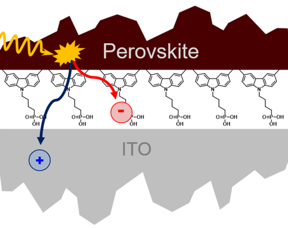Home > Press > Perovskite solar cells: Interfacial loss mechanisms revealed
 |
| The SAM layer between the perovskite semiconductor and the ITO contact consists of a single layer of organic molecules. The mechanisms by which this SAM layer reduces losses can be quantified by measuring the surface photovoltage and photoluminescence.
CREDIT HZB |
Abstract:
Losses occur in all solar cells. One cause is the recombination of charge carriers at the interfaces. Intermediate layers at such interfaces can reduce these losses through so-called passivation. Self-assembled monolayers (SAMs) with a carbazole core are particularly well suited for the passivation of semiconductor surfaces made of perovskite materials. A team led by HZB physicist Prof. Steve Albrecht together with a group from Kaunas Technical University in Lithuania demonstrated this some time ago, developing a silicon-perovskite-based tandem solar cell with a record efficiency of over 29 %.
Perovskite solar cells: Interfacial loss mechanisms revealed
Berlin, Germany | Posted on August 20th, 2021
Now, for the first time, a team at HZB has analysed the charge carrier dynamics at the perovskite/SAM-modified ITO interface in more detail. From time-resolved surface photovoltage measurements, they were able to extract the density of “electron traps” at the interface as well as the hole transfer rates using a minimalist kinetic model. Complementary information was provided by measuring the time-resolved photoluminescence.
“We were able to determine differences in passivation quality, selectivity and hole transfer rates depending on the structure of the SAM, and demonstrate how the time-resolved surface photovoltage and photoluminescence techniques are complementary,” explains Dr. Igal Levine, postdoc at HZB and first author of the paper. Time-resolved surface photovoltage proves to be a relatively simple technique for quantifying charge extraction at buried interfaces that could significantly facilitate the design of ideal charge-selective contacts.
####
For more information, please click here
Contacts:
Antonia Roetger
Office: 0049-308-062-43733
Expert Contact
Dr. Igal Levine
Copyright © Helmholtz-Zentrum Berlin für Materialien und Energie
If you have a comment, please Contact us.
Issuers of news releases, not 7th Wave, Inc. or Nanotechnology Now, are solely responsible for the accuracy of the content.
News and information
![]() Polymer electrolytes for all-solid-state batteries without dead zones August 20th, 2021
Polymer electrolytes for all-solid-state batteries without dead zones August 20th, 2021
![]() Missing jigsaw piece: engineers make critical advance in quantum computer design August 20th, 2021
Missing jigsaw piece: engineers make critical advance in quantum computer design August 20th, 2021
Perovskites
![]() Removing the lead hazard from perovskite solar cells July 16th, 2021
Removing the lead hazard from perovskite solar cells July 16th, 2021
![]() Researchers build structured, multi-part nanocrystals with super light-emitting properties May 28th, 2021
Researchers build structured, multi-part nanocrystals with super light-emitting properties May 28th, 2021
Possible Futures
![]() National 2D materials research center wins NSF funding: Boise State joins Penn State, Rice for Phase II expansion of ATOMIC center August 20th, 2021
National 2D materials research center wins NSF funding: Boise State joins Penn State, Rice for Phase II expansion of ATOMIC center August 20th, 2021
![]() National 2D materials research center wins NSF funding: Boise State joins Penn State, Rice for Phase II expansion of ATOMIC center August 20th, 2021
National 2D materials research center wins NSF funding: Boise State joins Penn State, Rice for Phase II expansion of ATOMIC center August 20th, 2021
![]() Polymer electrolytes for all-solid-state batteries without dead zones August 20th, 2021
Polymer electrolytes for all-solid-state batteries without dead zones August 20th, 2021
Discoveries
![]() Polymer electrolytes for all-solid-state batteries without dead zones August 20th, 2021
Polymer electrolytes for all-solid-state batteries without dead zones August 20th, 2021
![]() Missing jigsaw piece: engineers make critical advance in quantum computer design August 20th, 2021
Missing jigsaw piece: engineers make critical advance in quantum computer design August 20th, 2021
![]() From anti-icing coatings to protection of containers with flammable liquids: heating films with graphene nanotubes enter the market August 20th, 2021
From anti-icing coatings to protection of containers with flammable liquids: heating films with graphene nanotubes enter the market August 20th, 2021
Announcements
![]() Polymer electrolytes for all-solid-state batteries without dead zones August 20th, 2021
Polymer electrolytes for all-solid-state batteries without dead zones August 20th, 2021
![]() Missing jigsaw piece: engineers make critical advance in quantum computer design August 20th, 2021
Missing jigsaw piece: engineers make critical advance in quantum computer design August 20th, 2021
Interviews/Book Reviews/Essays/Reports/Podcasts/Journals/White papers/Posters
![]() Polymer electrolytes for all-solid-state batteries without dead zones August 20th, 2021
Polymer electrolytes for all-solid-state batteries without dead zones August 20th, 2021
![]() Missing jigsaw piece: engineers make critical advance in quantum computer design August 20th, 2021
Missing jigsaw piece: engineers make critical advance in quantum computer design August 20th, 2021
Energy
![]() HKUST scientists discover new mechanisms of activity improvement on bimetallic catalysts for hydrogen generation and fuel cells August 13th, 2021
HKUST scientists discover new mechanisms of activity improvement on bimetallic catalysts for hydrogen generation and fuel cells August 13th, 2021










